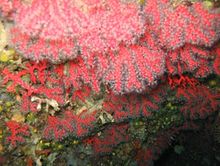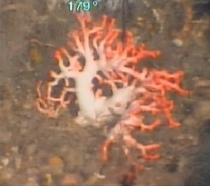Coralliidae
| Coralliidae | |
|---|---|

| |
Corallium rubrum
| |
| Scientific classification | |
| Domain: | Eukaryota |
| Kingdom: | Animalia |
| Phylum: | Cnidaria |
| Class: | Octocorallia |
| Order: | Alcyonacea |
| Suborder: | Scleraxonia |
| Family: | Coralliidae Lamouroux, 1812 |
Genera
| |
|
see text | |
Coralliidae, also known as precious corals, is a taxonomic family of soft corals belonging to the suborder Scleraxonia of the phylum Cnidaria.[1] These sessile corals are one of the most dominant members of hard-bottomed benthic environments such as seamounts, canyons and continental shelves.[2] From this coral family results 69 descendants[3] in which each species plays a key role in forming habitats for a variety of marine species.
Due to their unique trait of possessing a red calcium carbonate skeleton, these corals can be harvested in order to create handcrafted amulets, jewelry and other valuable artifacts, giving rise to its reputed name of "precious corals".[4] Correspondingly, members of this family are vulnerable to the negative impacts of overharvestation imposed by mass coral trade.[5]
Description
Members of this family Coralliidae are also considered "soft corals" which are sedentary, colonial polypoids. Animals of this class have a simple cup shaped body that consists of two layers of cells, sloping peripheral platforms and wide axial pits. Each of these members have 8 unpaired, pinnate and 8 mesenteries utilized for filter feeding and defense.[6] All species have numerous calcareous skeletal elements called sclerites that can be found on the surface ranging from 3 mm to 5 mm, diverging in many directions. The endoskeleton is composed of tiny stick-like calcium carbonate rods that fuse together to form a rigid structure which may be colored red, pink, or white. Coralliidae exhibit two different distributions within a colony and their spacing across the colony surface. Corals can be either roughly equal in size and evenly distributed across the colony surface, or unevenly distributed and vary in size. However, the general trend observed is one of a proportionally positive relationship between coral colony age and polyp and height size.[2]
This family can be further classified, based upon their polyps distribution, into three genera based :
| Genera | Description | Image |
|---|---|---|
| Corallium | This species is composed of small bumps (verracuae) that are slightly elevated from the surface of the corals. These verracue surround the entirety of the coral. The color of the cortex varies from the more common crimson red to the rarer yellow color to the even more rare color white.[7] |  |
| Hemicorallium | The verrucuae within this coral are slightly raised, like Corallium, but confined to one surface near the edges of the main branches forking in one direction. The color of the cortex is usually a cream white and the axis contains light red tints.[7] |  |
| Paracorallium | This genera is characterized by sclerite crosses and 6 and 8-radiate capstans that may or may not be symmetric which can give rise to smooth double clubs in some species in this genera. The color of the cortex is usually light red with the axis having light pint tints.[8] |  |
Distribution
Species belonging to this family of Coralliidae typically inhabit
Biological Behavior
Feeding
All polyps of the order Alcyonacea consists of tentacles and pinnules to capture food. The tentacles located on the coral lie in the same plane as the mesenteries, concave oral discs, but are bent slightly forward or backward. This orientation is beneficial in the feeding process as the tentacle(s) can enter what is known as the preparatory feeding position, giving rise to the raptorial manner of feeding observed in these corals.
Once food is captured by the tentacles, it will flex toward the mouth, where the food will then be sucked into the pharynx. After the tentacle is free of the food particle, it will then be flexed outward and assume the preparatory feeding position again. In order to capture bigger prey like brine shrimp, several tentacles must repeat the raptorial manner of feeding in conjunction.[11]
Reproduction
Within this family of the order Alconycea, also known as
Defense/Predation
These soft corals have nematocysts and allelochemicals, sclerites and other protective mechanisms that make them rarely predated upon. Along with these defense systems, corals have low nutritional value, therefore making them unpreferable as a choice of food.[14]
Overexploitation by Coral Trade
Coral fisheries impose detrimental effects on coral colonies within oceans around the world. Before the 1970s, fisheries involved extraction of coral using net attached dredges or small sailboats. However, by the 1970s, fisheries started to stray away from sail boats and began to utilize motorized boats that consisted of metal dredges much longer than those used prior to the 70s. These motorized boats were also capable of carrying much heavier weight aboard thus causing damage to the coral colonies underneath leading to limited a supply of corals.[15]
Due to the slow growth period of these corals, they cannot keep up with the rates in which coral harvesting occurs by these fisheries resulting in overexploitation. One area that experienced this decline in fishing yields was the Mediterranean Ocean in the 1980s, and as a result the United Nations soon placed guidelines on coral harvestation and banned dredging for corals in 1994. However, recently data has shown ongoing declining population numbers of the corals, which prompted the EU and the US to include the family Corallidae in the CITES Appendix II in order to regulate its trade.[16]
References
- ^ "Coralliidae Lamouroux, 1812". World Register of Marine Species. Retrieved 21 April 2021.
- ^ Elsevier Science Direct.
- NCBI. Retrieved 21 April 2021.
- ^ de Carvalho, Rui Galopim (2018). "Precious corals" (PDF). InColor. 37. International Colored Gemstone Association: 70–78 – via Google Scholar.[dead link]
- – via Elsevier Science Direct.
- Proceedings of the Biological Society of Washington. 4: 840–867 – via Google Scholar.
- ^ Proceedings of the Zoological Society of London. 1882: 14 – via Internet Archive.
- ^ Cairns, Stephen (2003). "A new genus of the scleraxonian family Coralliidae (Octocorallia: Gorgonacea)" (PDF). Proceedings of the Biological Society of Washington. 1: 222–228 – via Google Scholar.
- ^ a b de Carvalho, Rui Galopim (2018). "Precious corals" (PDF). InColor. 37. International Colored Gemstone Association: 70–78 – via Google Scholar.[dead link]
- ^ Cau, Angela; Cannas (17 July 2013). "Adaptive Management Plan for Red Coral in the GFCM Competence Area" (PDF): 1–65 – via Google Scholar.
{{cite journal}}: Cite journal requires|journal=(help) - .
- ^ Simpson, A. (1 March 2011). "Precious Corals (Coralliidae) from North-Western Atlantic Seamounts". Marine Sciences Faculty Sciences – via JSTOR.
- Gale Academic OneFile.
- – via Elselvier Science Direct.
- – via Elsevier Science Direct.
- – via Elsevier Science Direct.
